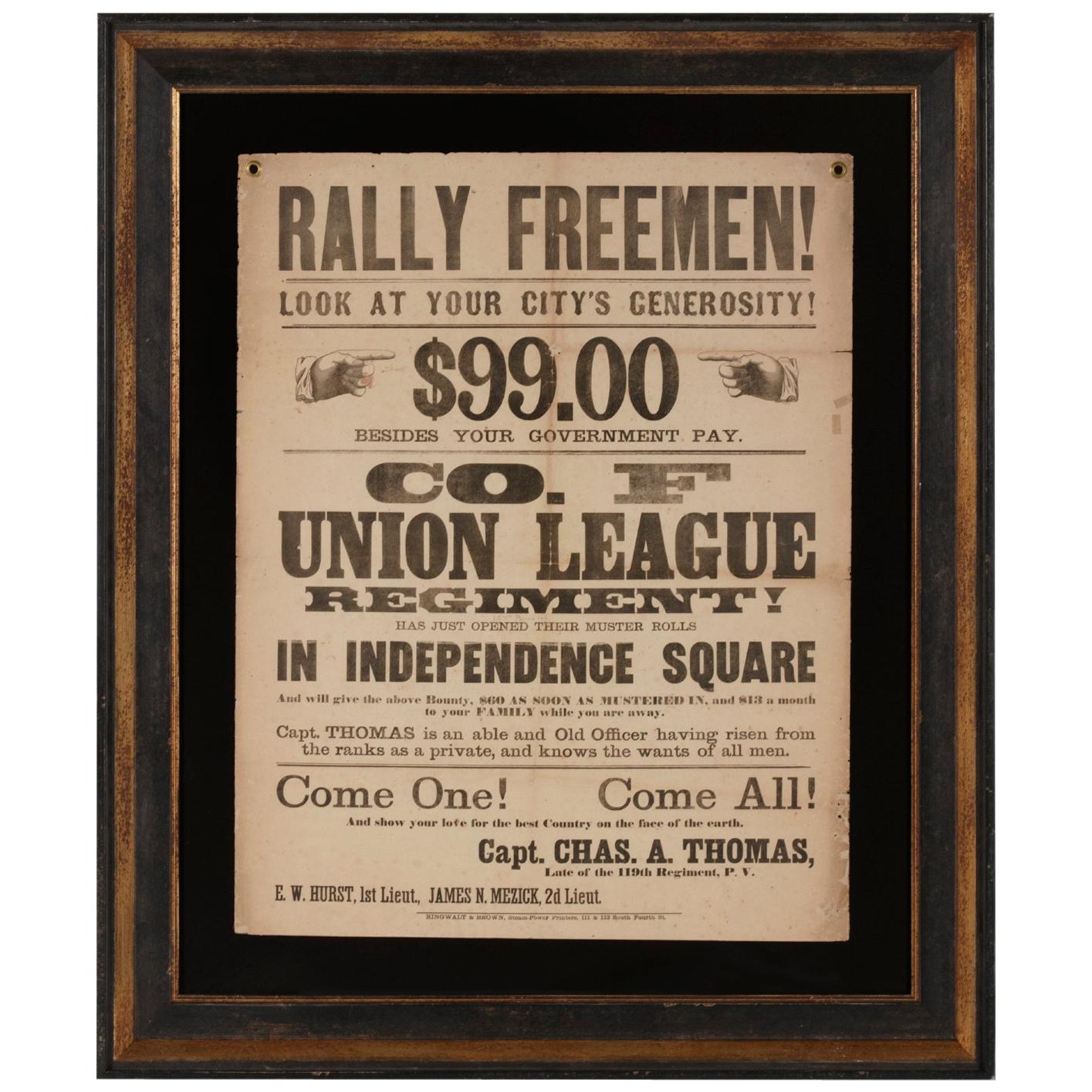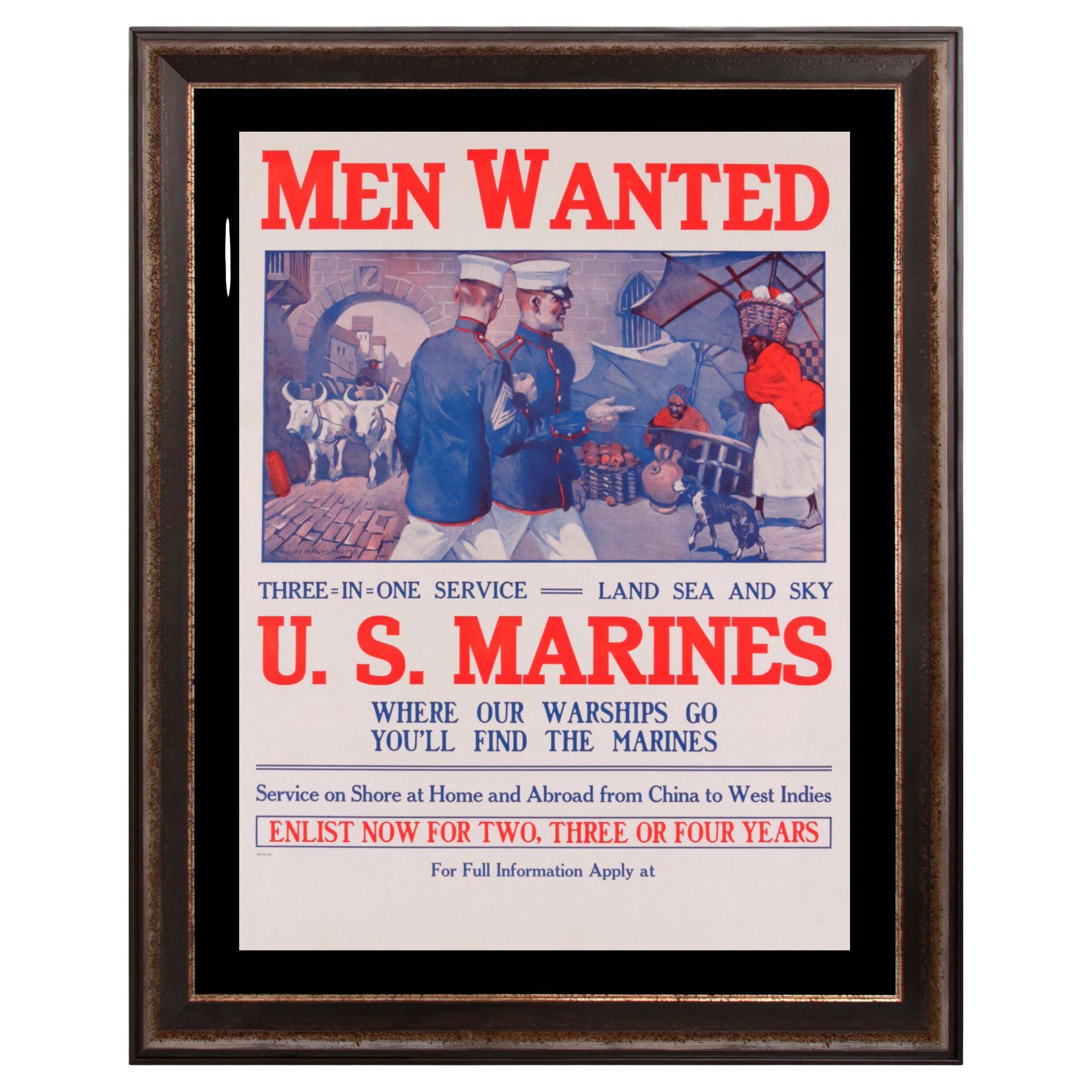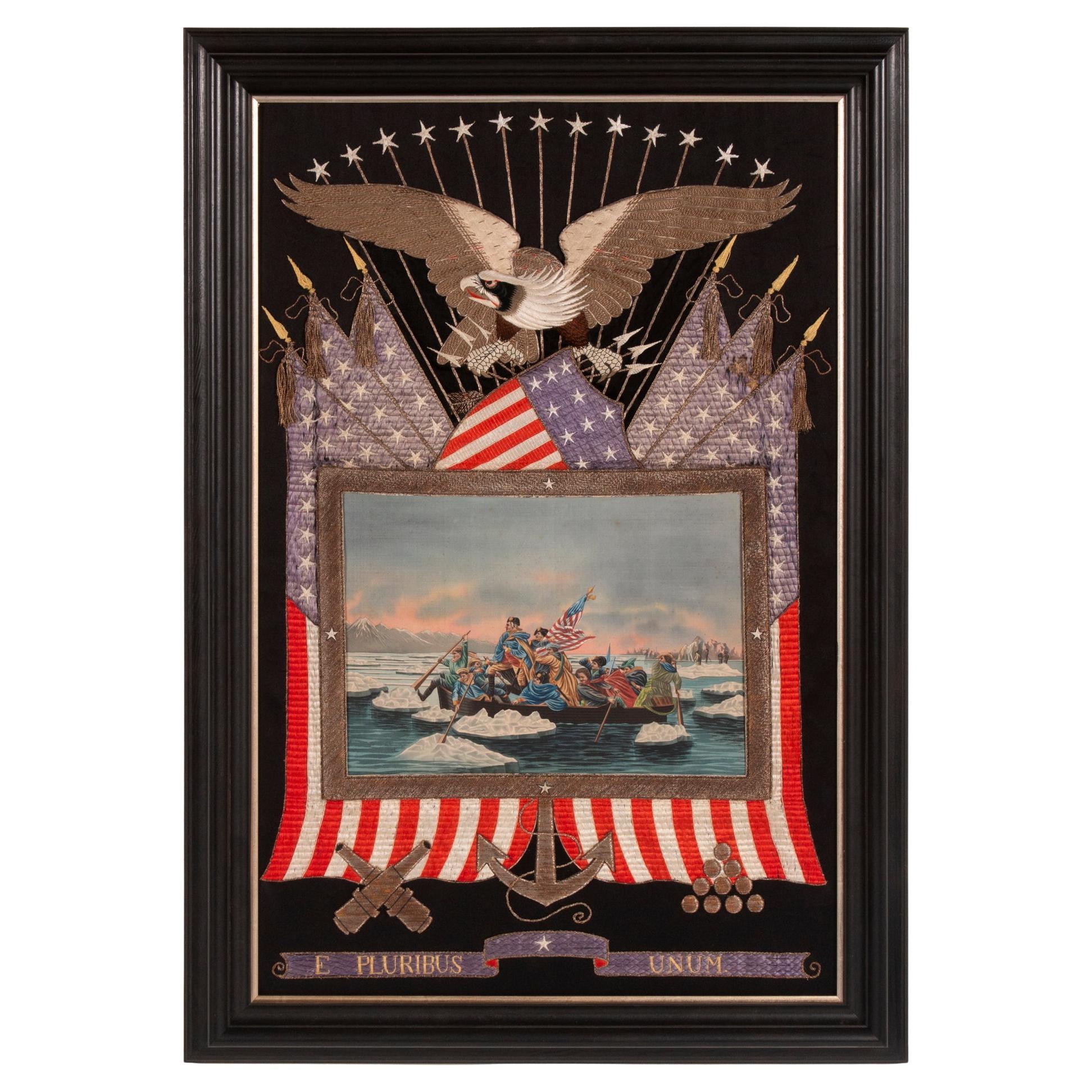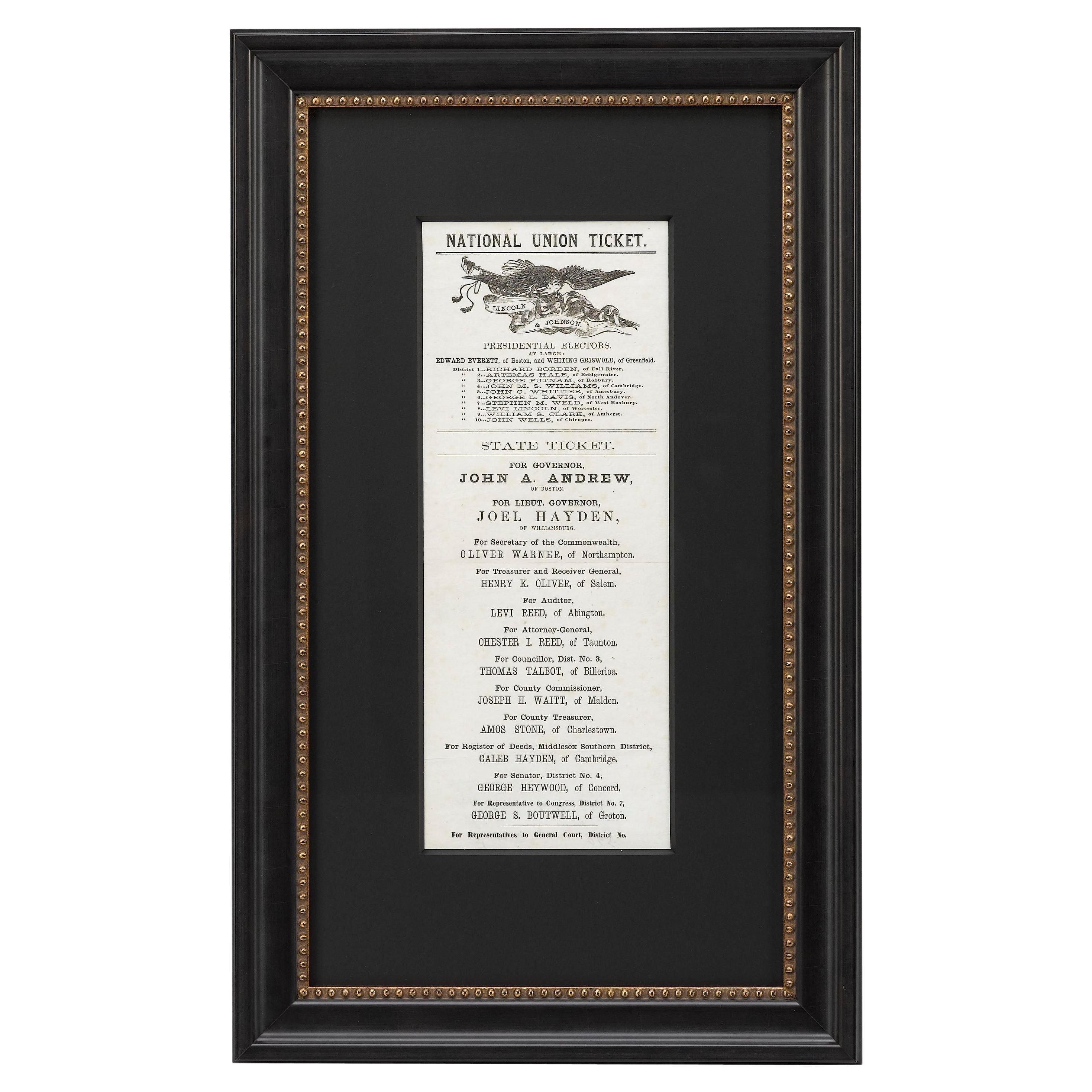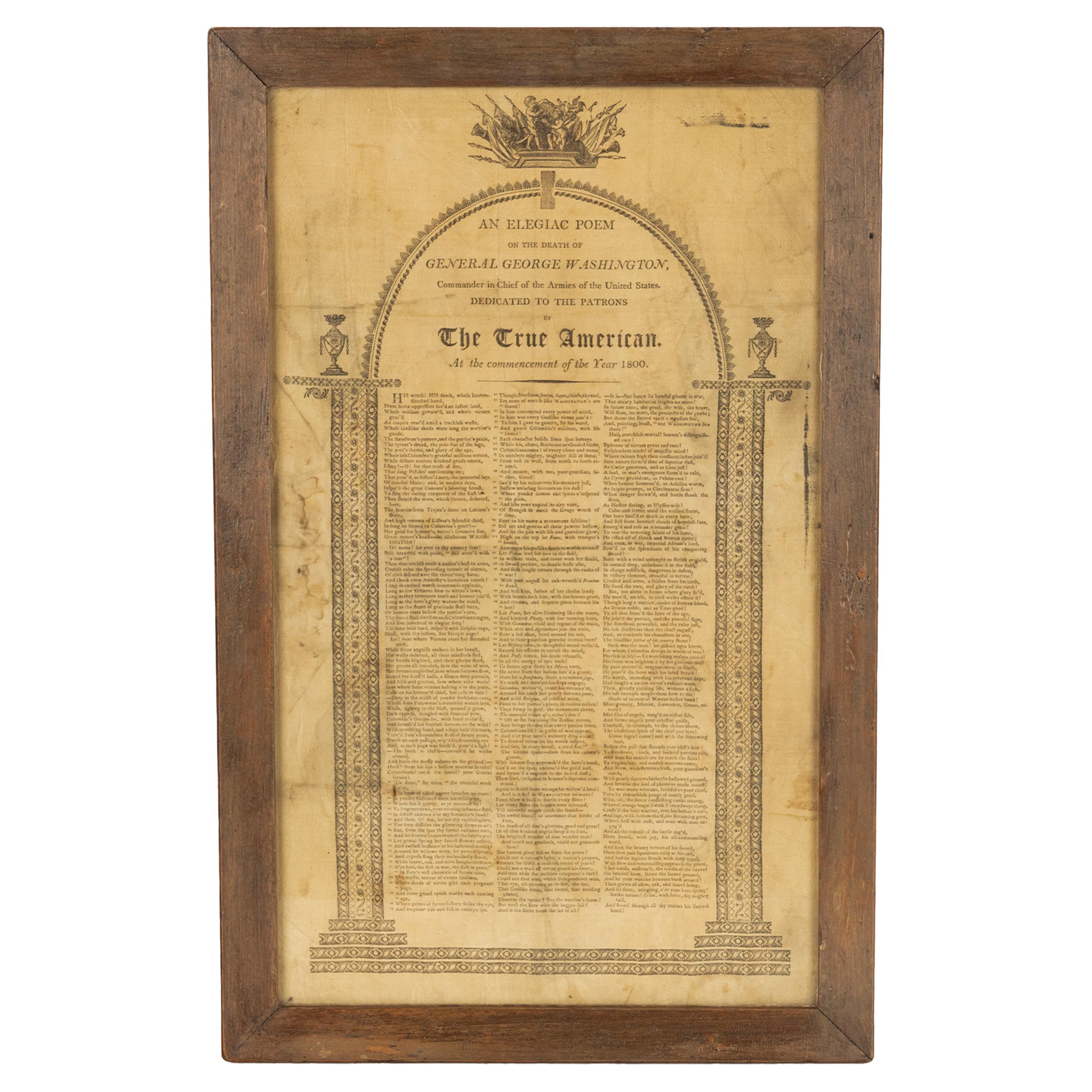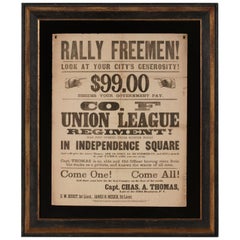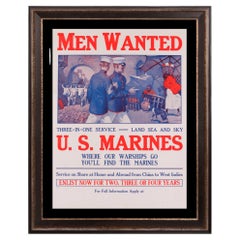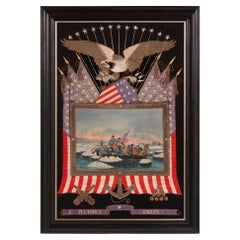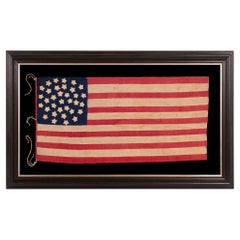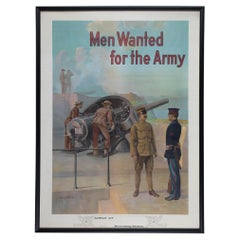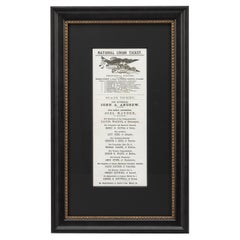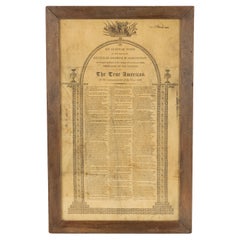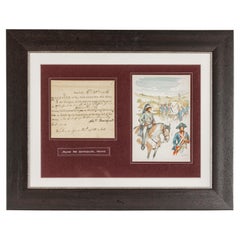Items Similar to Colorful Civil War Recruitment Broadside for the "Manhattan Rifles"
Want more images or videos?
Request additional images or videos from the seller
1 of 8
Colorful Civil War Recruitment Broadside for the "Manhattan Rifles"
Price Upon Request
Price Upon Request
Price Upon Request
Price Upon Request
Price Upon Request
Price Upon Request
Price Upon Request
Price Upon Request
Price Upon Request
Price Upon Request
Shipping
Retrieving quote...The 1stDibs Promise:
Authenticity Guarantee,
Money-Back Guarantee,
24-Hour Cancellation
About the Item
MASSIVE & COLORFUL CIVIL WAR RECRUITMENT BROADSIDE FOR THE "MANHATTAN RIFLES,” WHICH MUSTERED INTO 43RD AND THE 57TH NEW YORK INFANTRY DIVISIONS IN THE WAR'S OPENING YEAR, EASILY AMONG THE ABSOLUTE BEST OF ITS KIND, 1861
Massive & colorful broadside for the "Manhattan Rifles," with a large and detailed image of a Zouave-uniformed, Civil War soldier, surrounded by verbiage in a fanciful array of fonts. The text reads as follows: "Manhattan Rifles!; Lieut. Co. Goe. F. Watson. Comm'dg.; Officers' Headquarters. No. 461 Broome St., Near Mercer; Major Jno. M. Freeman; Recruiting Stations, Mercer House. Cor, Broome and Mercer; Stuyvesant Hall. 633 Broadway; And at Chesters 38 Ann Street.; The Colonel of the Regiment Is a United States Officer. And every care will be taken for the Comfort of the Men, who will, immediately on enlistment, be placed in good quarters.; Musicians Wanted for the Band." Along the bottom margin is the byline of the printer, which reads: "S. Booth, Printer, 59 Duane Street, cor. of Elm."
Across all Civil War recruitment posters that have survived to the present day, this is on the short list of the very best. Only a couple of other extraordinary varieties might vie for the title. In addition to the magnitude of its design among its peers, the broadside is also extremely rare. Only one other copy, in the collection of the New York Historical Society, is presently known.
While the Manhattan Rifles were recruited, apparently in both New York City and Schenectady, the men were immediately dispersed to help form the 43rd and the 57th New York Infantry regiments. These organized on September 1st and October 1st of 1861, respectively. While the men went in either direction without either George F. Watson or John M. Freeman, the nickname seems to have followed its men to G Company of the 43rd New York, which, in 1862, consolidated and was re-designated C Company. Both regiments earned well-deserved reputations, especially the 43rd, which was among the most die-hard fighting units of the Union Army. Both were at Gettysburg and both have monuments, though neither was heavily engaged there, winning much of their glory elsewhere.
The Manhattan Rifles were to have been raised by Lieutenant Colonel George F. Watson, who, according to the content of the broadside, was a United States [Army] Officer. Curiously, I can find no previous military record for Watson, though one source that I found cites that a man by this name, residence unknown, enlisted the following year at the rank of 1st Lieutenant, at age 34, and was promoted to Adjutant on the same day. This took place at New York City, on February 3rd, 1862, and he mustered into Field & Staff of the 12th New York Infantry. Records at the New York State Military Museum are slightly contradictory, citing that he was actually promoted to Adjutant under Colonel Henry A. Weeks, on January 28th, a few days beforehand. Given his age, older than most recruits, Watson could have been a member of a state or local militia unit, who was offered a commission into regular army, at the rank of Lieutenant Colonel, in conjunction with his forthcoming command of the Manhattan Rifles. In some cases, if not enough men could be recruited, the regiment didn't form and its men were dispersed. It could be that when the Manhattan Rifles were consolidated with others, Watson lost his promised commission and took on some other role, remaining outside the regular army until early in 1862, when he enlisted. Whatever the case may be, he appears to have survived the war, mustering out at Elmira, New York, on May 17th, 1863. Although I could not locate any other definitive information, I found a George Francis Watson, born in New York City on October 1st, 1830, who married one Harriet T. Ball (b. 1832, d. 1912) in 1858, died sometime in 1904, buried in the "Watson Family plot" in Leland, Illinois. Although his date of birth is slightly off, the name is far less common than one might imagine. It could be that he was, in fact, 32 years of age at the time of enlistment, either lying about or uncertain of his age.
Major John M. Freeman is a veritable ghost. While there are several men by this name who served, I can find no one who appears likely to b offered the rank of Major in the 1861 organization of a regiment, or who came in as an officer afterwards. His only reference is in the database of the New York State Military Museum with regard to the consolidation of the Manhattan Rifles into the 43rd New York. No one by that name went on to serve in either the 43rd or the 57th New York Infantries.
One of the more interesting things about this broadside is a prominent advertisement for musicians. At the outbreak of the war, it was generally believed that victory would come easily and funds were expended liberally on all manner of pleasantries that would have far less emphasis as reality set in. In their book, "Bands and Drummer Boys of the Civil War" (1966, Thomas Yoseloff, New York, South Brunswick, London), authors Arthur Wise and Francis A. Lord describe just how significant of a role bands played in the late spring and summer of 1861. While General Orders of the War Department allowed for no more than 24 musicians for each infantry and artillery regiment in the Regular Army, Wise and Lord explain: "At the beginning of the war, every [volunteer] regiment had a full brass band, some numbering as high as 50 pieces. There were 4 to 5 regiments in each brigade, 3 brigades in each division, 3 divisions in each corps. This meant that each corps had between 36-40 bands. Accordingly, it was felt necessary to reduce this number to one band per brigade." This evaporated pretty quickly. They continue: "As early as October 26, 1861, by General Order No. 91, of the Adjutant General's Office, no more bands for volunteer regiments were to be mustered into service, and no vacancies in existing bands were to be filled. Moreover, all band members who were not musicians were to be discharged by their regimental commanders." The reason was simple economics. "The cost of bands was so heavy," say Wise and Lord, "that as early as December 5, 1861, the Paymaster General reported that…this would result in a saving of about five million dollars."
Brief History of the 43rd New York Volunteer Infantry:
This regiment, Col. Francis L. Vinton commanding, received its State designation September 18, 1861; was organized at Albany and there mustered in the service of the United States for three years in August and September, 1861. The Yates' Rifles, recruited by Col. L. Ayer, four incomplete companies, A, B, C and D, were consolidated into two companies, and September 18, 1861, assigned to this regiment. A company of the Manhattan Rifles, Col. J. M. Freeman, and of the U. S. Volunteers, Col. Wm. Northedge, were also attached to the regiment, and its organization completed. The two companies of the Yates Rifles joined the regiment on its passage through New York city. July 18, 1862, the regiment was consolidated into five companies, A, B, C, D and E, the men of Company K going to Company A; those of F to B; of G to C; of I to D, and of H to E; and in October, 1862, five new companies joined, completing the reorganization of the regiment.
The companies were recruited principally: A, B and D at Albany; C at Albany and Oneonta; E at Canajoharie; F at Sandy Hill; G — Manhattan Rifles— at Schenectady; H and I—Vales' Rifles — at New York city; and K—U. S. Volunteers — at Cooperstown. The companies joining in October, 1862, were recruited at Albany.
On Sept. 21, the regiment left the state for Washington, 700 strong. It went into camp at Alexandria, Va., being first assigned to Hancock's brigade, Smith's division, 4th corps, Army of the Potomac, and in May, 1862, to the 1st brigade, 2nd division, 6th corps, with which it participated in the siege of Yorktown, fought at Lee's mill, Williamsburg, and in the Seven Days' battles, losing in that week 71 killed, wounded and missing. Owirig to reduction in numbers, the regiment was consolidated on July 18, 1862, into a battalion of five companies. The 43d took part in the battle of Antietam, went into camp at Sharpsburg, Md., where five new companies joined it in October, and was next actively engaged at Fredericksburg, after which it established winter quarters at Fal-mouth. As part of the light brigade, 6th corps, it fought in the Chancellorsville campaign, losing 138 men at Salem Church, and 66 in the assault upon Marye's heights. It again encountered the enemy at Deep Run crossing in June, when the loss of the light brigade was so severe that it was broken up and the 43d was assigned to the 3d brigade, 2nd division, 6th corps, with which it continued to serve during its term of enlistment. The brigade reached Gettysburg on July 2, after a forced march, and went into action the next day. During the autumn of 1863, it encountered the enemy at Rappahannock Station, Locust Grove, Auburn and Mine Run, and finally established winter quarters at Brandy Station in December, when 217 members reenlisted and immediately received their veteran furlough. Camp was broken on May 3, 1864, for the Wilderness campaign which proved to be the most fatal for the 43d of any during its service. In the battle of the Wilderness the total loss was 198 members, including 3 field officers killed or mortally wounded. Although reduced to an effective force of 7 officers and 92 men, the regiment was active at Spottsylvania, the North Anna, Totopbtomy and Cold Harbor and shared in the first assault on Petersburg. At the time of Early's raid, the 6th corps was hurried to Washington and repulsed the enemy at Port Stevens, where Col. Visscher, and 5 enlisted men were killed and 29 wounded. Continuing the campaign in the Shenandoah Valley, the regiment was engaged at Charlestown, the Opequan, Fisher's hill, and Cedar Creek. The original members not reenlisted were mustered out at Albany, Sept. 29, 1864, and 15 officers and 400 veterans and recruits remained in the field, in camp at Winchester. On Dec. 5, the regiment returned to Petersburg and was posted near Fort Stedman. It shared in the final assault April 2, 1865, in the battle of Sailor's creek, and was present at the surrender of Lee's Army at Appomattox. The 6th corps was then stationed for a short time at Danville, Va., after which it participated in the grand review of the Union armies at Washington, where the 43d was mustered out on June 27, 1865. The total strength of the regiment was 2,327 members, of whom 692 were killed, wounded or captured, 94 died from accident or disease, and 27 perished in prison. The deserved reputation of the 43d as a crack fighting regiment is confirmed by Col. Fox, who names it one of the "three hundred fighting regiments."
Sources: The above history taken mostly verbatim from a combination of two sources: Phisterer, Frederick, "New York in the War of the Rebellion, 3rd Ed." (1912, J. B. Lyon Co., Albany), and "The Union Army: A History of Military Affairs in the Loyal States, 1861-65; Records of the Regiments in the Union Army; Cyclopedia of Battles; Memoirs of Commanders and Soldiers (1908, Federal Publishing Co. Madison, WI), vol II.
Brief History of the 57th New York Volunteer Infantry:
This regiment mustered at New York City on October 1st, 1861 for a 3-year term of service. It received its numerical designation on October 19th of the same year. It was formed between August 12th and November 19th by the consolidation of several organizations, recruited under special authority from the War Department. The National Guard Rifles or Zook's Voltigeurs, Col. Samuel K. Zook, formed Companies A, B, C, D and E; the Clinton Rifles, Col. J. A. Page, became Companies F, G and H (A and E = F and G; D, F and G=H); the United States Voltigeurs or Volunteers (Companies B and C), Col. Albert C. Ramsay, formed Companies I and K; and Samuel K. Zook was appointed Colonel of the regiment, which resulted in the addition nickname Zook's Voltigeurs. Before this consolidation the Washington Zouaves, Col. James H. Remain, had been merged into the Voltigeurs, and the Manhattan Rifles, Col. George W. Vanderbilt, in the National Guard Rifles.
The companies were recruited principally: A, D, E, F and G in New York city; B in Utica; C in Kings county; and H, I and K in Dutchess county. The regiment left the State November 19, 1861; served in French's Brigade, Sumner's Division, Army of the Potomac, from November, 1861; in the same, 3d, Brigade, 1st, Richardson's, Division, 2d Corps, Army of the Potomac, from March 13, 1862; commanded by Zook, Caldwell and Hancock respectively, at Gettysburg; it was part of the Consolidated Brigade, same division and corps, from July to November, 1864; and the two companies remaining in the field, E and G, were, December 6, 1864, transferred to the 61st Infantry.
During its service the regiment lost by death, killed in action, 5 officers, 60 enlisted men; of wounds received in action, 3 officers, 35 enlisted men; of disease and other causes, 1 officer, 90 enlisted men; total, 9 officers, 185 enlisted men; aggregate, 194; of whom 28 enlisted men died in the hands of the enemy.
The regiment left for Washington on Nov. 19th, 1861, was assigned to French's brigade, Sumner's division, Army of the Potomac, and passed the winter in the vicinity of Washington. In March, 1862, it was attached to the 3rd Brigade, 1st Division, 2nd Corps, and joined in the general advance to Manassas Junction. It then moved to the Peninsula, participated in the siege of Yorktown; was present at the battle of Fair Oaks; active in the Seven Days' battles, after which it proceeded to Harrison's landing. It went to the support of Gen. Pope at Bull Run and arrived just before the battle of Chantilly, but was not actively engaged. At Antietam the regiment lost 98 in killed and wounded and 3 missing. After the battle it moved to Halltown, Snicker's gap and Falmouth and suffered severely at Fredericksburg, where the division, under Gen. Hancock made a gallant but unsuccessful assault on Marye's heights. The regiment here lost 87 out of 192 engaged. The winter was passed near Falmouth and in the Chancel-lorsville campaign in the spring of 1863 the regiment was active. At Gettysburg the loss of the depleted command was 34 and then moving southward with the army, the 57th was active at Auburn, Bristoe Station and in the Mine Run campaign. Winter quarters were established near Brandy Station and occupied until the opening of the Wilderness campaign, during which the regiment was repeatedly in action. In the battle at the Wilderness the loss was 58, and in the assault on Petersburg, June 15, the action at the Weldon railroad, and at Reams' station the loss was 63.
Co. C was mustered out on July 14, 1864; Cos. F, D and I in August; Cos. K, A and B in September; Co. H on Oct. 15; and the reenlisted men and recruits were transferred to the 61st N. Y. infantry on Dec. 6. The regiment during its term of service lost 103 by death from wounds and 91 from other causes.
Sources: The above history taken mostly verbatim from a combination of two sources: Phisterer, Frederick, "New York in the War of the Rebellion, 3rd Ed." (1912, J. B. Lyon Co., Albany), and "The Union Army: A History of Military Affairs in the Loyal States, 1861-65; Records of the Regiments in the Union Army; Cyclopedia of Battles; Memoirs of Commanders and Soldiers (1908, Federal Publishing Co. Madison, WI), vol II.
Provenance: Ex-Norm Flayderman.
Mounting: This is a pressure mount between 100% cotton twill, black in color, and U.V. protective acrylic (Plexiglas). The banner was mounted and framed within our own conservation department, which is led by expert staff. The exceptional quality gilded, French molding has an early American profile. To this a rippled profile molding, black with gold highlights, was added as both a liner and a cap. We take great care in the mounting and preservation of flags and related objects and have framed thousands of examples.
Condition: Please inquire about condition. Report to follow.
Frame size (H x L): 58.5" x 45.25"
Flag size (H x L): 45.75" x 32.5".
- Dimensions:Height: 58.5 in (148.59 cm)Width: 45.25 in (114.94 cm)Depth: 3 in (7.62 cm)
- Materials and Techniques:
- Place of Origin:
- Period:
- Date of Manufacture:1861
- Condition:See item Description.
- Seller Location:York County, PA
- Reference Number:Seller: pat-3631stDibs: LU849718572792
About the Seller
5.0
Recognized Seller
These prestigious sellers are industry leaders and represent the highest echelon for item quality and design.
Established in 1991
1stDibs seller since 2008
70 sales on 1stDibs
Typical response time: 1 to 2 days
- ShippingRetrieving quote...Shipping from: York County, PA
- Return Policy
Authenticity Guarantee
In the unlikely event there’s an issue with an item’s authenticity, contact us within 1 year for a full refund. DetailsMoney-Back Guarantee
If your item is not as described, is damaged in transit, or does not arrive, contact us within 7 days for a full refund. Details24-Hour Cancellation
You have a 24-hour grace period in which to reconsider your purchase, with no questions asked.Vetted Professional Sellers
Our world-class sellers must adhere to strict standards for service and quality, maintaining the integrity of our listings.Price-Match Guarantee
If you find that a seller listed the same item for a lower price elsewhere, we’ll match it.Trusted Global Delivery
Our best-in-class carrier network provides specialized shipping options worldwide, including custom delivery.More From This Seller
View All"Rally Freemen!..." Civil War Recruitment Broadside
Located in York County, PA
"RALLY FREEMEN! …COME ONE! COME ALL! AND SHOW YOUR LOVE FOR THE BEST COUNTRY ON THE FACE OF THE EARTH." A CIVIL WAR RECRUITMENT BROADSIDE FOR THE...
Category
Antique 1860s American Political and Patriotic Memorabilia
Materials
Paper
Marine Corps Recruitment Poster by Sidney Riesenberg ca 1910-1916
Located in York County, PA
EXTRAORDINARY MARINE CORPS RECRUITMENT POSTER BY SIDNEY RIESENBERG (1885-1971), WITH SHARPLY APPOINTED OFFICERS STROLLING IN AN EXOTIC LOCAL, LIKELY DERNA OR MARRAKESH (i.e., “THE SH...
Category
20th Century American Political and Patriotic Memorabilia
Materials
Paper
Price Upon Request
Elaborate Sailor Souvenir of Washington Crossing the Delaware, circa 1885-1912
Located in York County, PA
Elaborate sailor’s souvenir embroidery from the orient with a beautiful hand-painted image of Washington crossing the Delaware, surrounded by a large eagle, federal shield, crossed flags, a cannon, cannonballs, and anchor, circa 1885-1910:
Between roughly 1880 and 1915, American sailors visiting the orient could obtain beautiful needlework embroideries on shore, with patriotic American themes. These extraordinary works of art were acquired as mementos of a long voyage, often with the hope that they might be presented as gifts for loved ones and friends.
Using silk floss, elaborately embellished with both silver and gold metallic bullion thread...
Category
Antique Late 19th Century Asian Political and Patriotic Memorabilia
Materials
Silk
34 STAR AMERICAN FLAG, CIVIL WAR, 1861-63, KANSAS STATEHOOD, 2nd KY CAVALRY
Located in York County, PA
34 STAR ANTIQUE AMERICAN FLAG OF THE CIVIL WAR PERIOD (1861-63), IN A TINY SCALE AMONG PIECED-AND-SEWN FLAGS OF THE PERIOD, WITH A TRIPLE-WREATH CONFIGURATION, AN ELONGATED FORMAT, AND ENTIRELY HAND-SEWN; FOUND WITH A LETTER FROM JOHN W. RUDE OF THE 2ND KENTUCKY VETERAN VOLUNTEER CAVALRY (UNION):
34 star flag of the Civil War period with a variety of extremely desirable features, handed down with a letter written by John W. Rude on November 8th, 1864, while encamped with the Army’s 1st Brigade, 3rd Division, as a member of the 2nd Regiment of Veteran Volunteer Cavalry. Tiny in scale among pieced and sewn examples, the flag displays a star pattern that consists of a three consecutive wreaths, with a single star in the very center. Because it lacks a single star in each corner, outside the basic pattern—usually present in flags of this design made during the mid-late 19th century—this is something I classify as a “snowball medallion.” Entirely hand-sewn throughout, note the square format of the blue canton, with its beautiful, circular star arrangement, and how interesting this combination is when paired with the elongated format of the flag itself. The stars are double-appliqued, meaning that they are applied to both sides. These are fat in shape and inconsistent in size. Note how the lowest star in the outermost ring actually dips into the white stripe below.
Made of plain weave cotton, there is a narrow binding along the hoist, red in color, with three sets of cotton ties. Those at the top and bottom are made of fine, braided hemp or hemp and cotton cord, stitched into place, while the one in the center, looped around the binding and tied, is made of lightweight, twisted, cotton thread. Note how the 5th, 6th, and 7th red stripes are pieced from two lengths of cotton fabric, which reflects that the maker was being conscious of conserving available fabric.
In the 19th century, most flags with pieced and sewn construction were 8 feet long and larger. A six-footer was considered small. Even military battle flags, carried on foot, measured 6’ x 6.5’, which translates into approximately 7’ x 7.5’ after framing, about the size of an average quilt and larger than can comfortably fit on a wall in a house with 8-foot ceilings and average width baseboard. Flags smaller than this exist, but the smaller they get, the more unusual they are. At just 1.5’ x 3’, this is about as small as one will ever encounter in a sewn flag of the Civil War era.
The flag appears to have likely been hand-carried. I expect that it probably saw military use of some sort as a camp flag...
Category
Antique 1860s American Political and Patriotic Memorabilia
Materials
Cotton
Hunt Brother Circus & Wild West Show Three-Sheet Broadside, circa 1900-1910
Located in York County, PA
Three-sheet, narrow, vertical broadside, made to advertise Hunt Brothers Circus and Wild West Show ca 1900-1910. With the bold headlines “Buffalo Ranch”...
Category
Early 20th Century American Posters
Materials
Paper
34 Stars in an Outstanding Oval Medallion Configuration, Civil War Period
Located in York County, PA
34 STARS IN AN OUTSTANDING OVAL MEDALLION CONFIGURATION, ON A NARROW CANTON THAT RESTS ON THE 6TH STRIPE, ON A HOMEMADE, ANTIQUE AMERICAN FLAG OF THE CIVIL WAR PERIOD, ENTIRELY HAND-...
Category
Antique 1860s American Political and Patriotic Memorabilia
Materials
Cotton
You May Also Like
"Men Wanted For the Army" Vintage WWI Recruitment Poster
Located in Colorado Springs, CO
Presented is a vintage U.S. Army recruitment poster, dating to World War I. The poster depicts an Army officer conferring with a soldier. They stand next to an artillery battery, manned by two soldiers. Their fort looks over a cliff, with water and clouds completing the background. The text "Men Wanted for the Army" is printed in bold red letters at the top of the poster. The bottom margin of the poster includes a cartouche where the name of the recruiting station can be filled in.
The color lithograph was illustrated by Michael P...
Category
Vintage 1910s American Posters
Materials
Paper
1864 Lincoln & Johnson Boston Union Presidential Ticket
Located in Colorado Springs, CO
Presented is an original Massachusetts Union Presidential ticket for the November 8, 1864 election. The paper ticket is printed in black, headed by a large spreadwing eagle carrying ...
Category
Antique 1860s Political and Patriotic Memorabilia
Materials
Paper
Antique Silk Broadside An Elegiac Poem Death of President George Washington 1800
Located in Portland, OR
An important & rare antique American political printed silk broadside, an elegy on the death of President George Washington, dated 1800.
A poem on the Death of President George Was...
Category
Antique 1790s Federal Political and Patriotic Memorabilia
Materials
Silk
American Revolutionary 1780s War Bond, State of Connecticut in Custom Frame
Located in Yonkers, NY
An American Revolutionary war bond from the State of Connecticut from the late 18th century in custom black frame under glass. This late 18th-century American Revolutionary War bond ...
Category
Antique Late 18th Century American Prints
Materials
Glass, Wood, Paper
American Soldier in Regalia: A Turn-of-the-Century Chromolithographic Portrait
Located in Langweer, NL
Large original antique chromolithograph poster composed of three attached sheets, measuring 162 x 68 cm in total. It features a figure that seems to represent a military figure, stan...
Category
Antique Early 1900s Prints
Materials
Paper
$843 Sale Price
20% Off
Free Shipping
1908 Artillery & Musician Infantry Uniforms by Ogden, Antique Chromolithograph
Located in Colorado Springs, CO
This colorful lithograph by H. A. Ogden was published in 1908 by Brigadier General J. B. Allshire. Originally published as a comprehensive series of U. S. military uniforms, this pri...
Category
Antique Early 1900s American Historical Memorabilia
Materials
Paper
